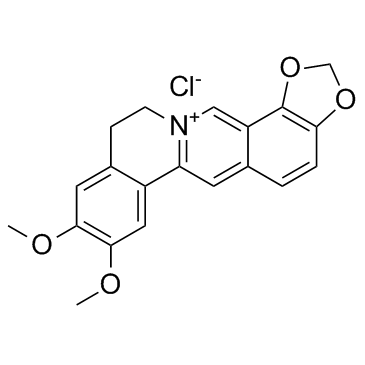Epiberberine chloride
Modify Date: 2024-01-08 18:29:12

Epiberberine chloride structure
|
Common Name | Epiberberine chloride | ||
|---|---|---|---|---|
| CAS Number | 889665-86-5 | Molecular Weight | 371.81 | |
| Density | N/A | Boiling Point | N/A | |
| Molecular Formula | C20H18ClNO4 | Melting Point | N/A | |
| MSDS | N/A | Flash Point | N/A | |
Use of Epiberberine chlorideEpiberberine chloride, a natural alkaloid, is a BACE1 inhibitor, which also exhibits inhibition activity on CYP2D6 and aldose reductase, alpha-adrenoceptors, acetylcholinesterase (AChE), butyrylcholinesterase, and b-site amyloid precursor protein cleaving enzyme 1. |
| Name | Epiberberine chloride |
|---|
| Description | Epiberberine chloride, a natural alkaloid, is a BACE1 inhibitor, which also exhibits inhibition activity on CYP2D6 and aldose reductase, alpha-adrenoceptors, acetylcholinesterase (AChE), butyrylcholinesterase, and b-site amyloid precursor protein cleaving enzyme 1. |
|---|---|
| Related Catalog | |
| In Vitro | Epiberberine has inhibitory effects on adipocyte differentiation and significantly decreases lipid accumulation by downregulating an adipocyte-specific transcription factor, sterol regulatory element-binding protein-1 (SREBP-1). Furthermore, epiberberine markedly suppresses the differentiation-mediated phosphorylation of components of both the Raf/mitogen-activated protein kinase 1 (MEK1)/extracellular signal-regulated protein kinase 1/2 (ERK1/2) and AMP-activated protein kinase-α1 (AMPKα)/Akt pathways. In addition, gene expression of fatty acid synthase (FAS) is significantly inhibited by treatment with epiberberine during adipogenesis. The anti-adipogenic effect of epiberberine is mediated by downregulation of the Raf/MEK1/ERK1/2 and AMPKα/Akt pathways during 3T3-L1 adipocyte differentiation. Moreover, the anti-adipogenic effects of epiberberine are not accompanied by modulation of β-catenin[2]. Epiberberine shows significant inhibition on CYP2D6 with IC50 value of 35.22 μM, but has no obvious inhibiting effect on the activities of CYP3A4, CYP1A2, CYP2E1 and CYP2C9[3]. |
| In Vivo | Epiberberine (23.35, 46.70 or 70.05 mg/kg/day) dose-and time-dependently reduces body weight gain of dyslipidemia hamster. The high dose of epiberberine (EBBR(H)) remarkably reduces the weight of epididymal adipose tissue, perirenal adipose tissue and liver by 17.1%, 31.9%, 18.4%, respectively[1]. |
| Animal Admin | After 4 weeks, dyslipidemia hamsters are determined according to the lipid levels including serum TC, TG, LDL-c and HDL-c and randomly divided into HFHC (n=10), three epiberberine-treated groups with a dose of 23.35, 46.70 or 70.05 mg/kg/day (n=10), 1.20 mg/kg/day of Sim is used as positive control (n=10). The animal dose of epiberberine is calculated by the human equivalent dose (3.5, 7 or 10.5 mg/kg, respectively) using the body surface area normalization method. In subsequent an 8-week experiment, these five groups are feed with HFHC diets. Every day, the animals in positive control and epiberberine-treated groups are administered with 0.7 mL compounds suspended in saline by gavage. NC and HFHC group receive 0.9% saline with the same volume by gavage. During the experiment, food intake is recorded every day; body weight is recorded every seven days, respectively. Feces of each hamster are collected at the 3rd day prior to termination of the study for the analysis of cholesterol and bile acids. |
| References |
| Molecular Formula | C20H18ClNO4 |
|---|---|
| Molecular Weight | 371.81 |
| Storage condition | -20°C |